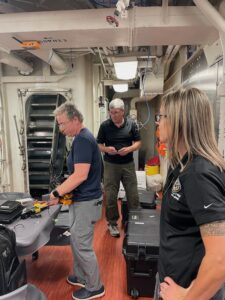
Story by John Marciano
Naval Health Research Center
SAN DIEGO – Scientists from the Naval Health Research Center (NHRC) operational readiness department studying sleep and fatigue performance among Sailors and Marines have outfitted guided-missile destroyer USS Curtis Wilbur (DDG 54) and its crew to participate in the study while at-sea. Approximately 200 sailors aboard the ship will be wearing devices (rings and watches) to monitor biometric data, primarily their total sleep time. Data from wearable devices can be used to identify individual sailors at high risk of fatigue and to predict fatigue risks across a shipboard department.
Trident Warrior, the experimentation sector of Rim of the Pacific (RIMPAC), is set to run June 27 to Aug. 1, in and around the Hawaiian Islands. RIMPAC is a biennial, large-scale, multinational maritime exercise involving 29 nations and more than 25,000 personnel.
This at-sea trial is part of NHRC’s larger Command Readiness, Endurance and Watchstanding (CREW) program that was established in partnership with Commander, Naval Surface Forces, to optimize human performance and fatigue management in the surface forces.
Massachusetts Institute of Technology (MIT) Lincoln Laboratory, NHRC’s CREW program technical partner, has customized data flows and data processing from commercial off-the-shelf wearable devices for secure and automatic transfer of sleep and other readiness data to a watchbill management program called Optimized Watchbill Logistics (OWL). Wearable sleep data are collected as personnel pass by data hubs located in common shipboard spaces, like mess areas and processed into OWL-ready format.
The OWL tool streamlines operational planning workflows and ship activity scheduling and enables real-time monitoring to detect and mitigate operational fatigue risk. Together, CREW and OWL act as a comprehensive solution to monitor and manage fatigue-related risk.
Dr. Rachel Markwald, NHRC’s principal investigator for the CREW program, explained that “the system is in a development cycle that includes iterative testing and refinements that (each time) get us closer to what the envisioned end state of this system will be: an offline, passive, intuitive, wearable device hub system that blends into the background of a ship without requiring extensive manual steps from either research staff or the crew of the ship.”
The goal of RIMPAC Trident Warrior 24 is to demonstrate the on-demand fatigue risk monitoring capabilities using the latest system, CREW System Version 2.0.
“Being aboard the Curtis Wilbur for RIMPAC while ships are operating at a high tempo, allows our research to be as realistic as possible,” said Navy Lt. Matthew Peterson, NHRC research physiologist. “Each time we go out to demonstrate the latest system, we learn how best we can implement this technology within the dynamic shipboard environment.”
NHRC’s mission is to optimize the operational readiness and health of our armed forces and families by conducting research, development, testing, and evaluation informing Department of Defense policy. NHRC supports military mission readiness with research and development that delivers high-value, high-impact solutions to the health and readiness challenges our military population faces on the battlefield, at sea, on foreign shores and at home. NHRC’s team of distinguished scientists and researchers consists of active duty service members, federal civil service employees and contractors, whose expertise includes physiology, microbiology, psychology, operations research and data science, epidemiology, and biomedical engineering.